The Interannual Cyclicity of Precipitation in Xinjiang During the Past 70 Years and Its Contributing Factors
Abstract
1. Introduction
2. Data and Methods
3. Results
4. Discussion
4.1. Potential Factors Influencing Precipitation Changes in Xinjiang
4.2. Significance of Different Factors on Interannual Precipitation Cyclicity in Xinjiang
4.3. Insights from Interannual Cycles for Future Precipitation Changes
4.4. Innovations and Limitations of the Study
5. Conclusions
Supplementary Materials
Author Contributions
Funding
Institutional Review Board Statement
Informed Consent Statement
Data Availability Statement
Acknowledgments
Conflicts of Interest
References
- Xu, D.; Lu, H.; Chu, G.; Liu, L.; Shen, C.; Li, F.; Wang, C.; Wu, N. Synchronous 500-year oscillations of monsoon climate and human activity in Northeast Asia. Nat. Commun. 2019, 10, 4105. [Google Scholar] [CrossRef] [PubMed]
- Li, Y.; Fleitmann, D.; Wang, X.; Pérez-Mejías, C.; Sha, L.; Dong, X.; Wang, D.; Zhang, R.; Qu, X.; Cheng, H. 550-Year climate periodicity in the Yunnan-Guizhou Plateau during the Late Mid-Holocene: Insights and implications. Geophys. Res. Lett. 2023, 50, e2023GL103523. [Google Scholar] [CrossRef]
- Zhao, D.; Lu, Z.; Wan, S.; Cheng, H.; Shi, X.; Li, A. Quaternary rainfall variability is governed by insolation in northern China and ice-sheet forcing in the South. Commun. Earth Environ. 2023, 4, 7. [Google Scholar] [CrossRef]
- Huang, E.; Zhao, M.; Wang, Y.; Tian, J. Quaternary precession cycles of sea-surface oxygen isotope records from the tropical western pacific. Quat. Sci. 2020, 40, 1464–1473. (In Chinese) [Google Scholar]
- Cheng, H.; Edwards, R.L.; Sinha, A.; Spötl, C.; Yi, L.; Chen, S.; Kelly, M.; Kathayat, G.; Wang, X.; Li, X. The Asian monsoon over the past 640,000 years and ice age terminations. Nature 2016, 534, 640–646. [Google Scholar] [CrossRef]
- Beck, J.W.; Zhou, W.; Li, C.; Wu, Z.; White, L.; Xian, F.; Kong, X.; An, Z. A 550,000-year record of East Asian monsoon rainfall from 10Be in loess. Science 2018, 360, 877–881. [Google Scholar] [CrossRef]
- Zhang, Z.; Huang, W.; Chen, J.; Liu, J.; Wei, H.; Chen, F. Multi-time scale analysis of East Asian summer monsoon and its possible mechanism during Holocene. Quat. Sci. 2017, 37, 498–509. (In Chinese) [Google Scholar]
- Raspopov, O.M.; Dergachev, V.A.; Esper, J.; Kozyreva, O.V.; Frank, D.; Ogurtsov, M.; Kolström, T.; Shao, X. The influence of the de Vries (∼200-year) solar cycle on climate variations: Results from the Central Asian Mountains and their global link. Palaeogeogr. Palaeoclimatol. Palaeoecol. 2008, 259, 6–16. [Google Scholar] [CrossRef]
- Liu, X.; Rao, Z.; Shen, C.C.; Liu, J.; Chen, J.; Chen, S.; Wang, X.; Chen, F. Holocene solar activity imprint on centennial-to multidecadal-scale hydroclimatic oscillations in arid central Asia. J. Geophys. Res. Atmos. 2019, 124, 2562–2573. [Google Scholar] [CrossRef]
- Huang, C.; Tian, X. Discussion on the driving mechanism of solar activity to interannual-suborbital-scale climate change. Quat. Sci. 2018, 38, 1255–1267. (In Chinese) [Google Scholar]
- Hu, F.S.; Kaufman, D.; Yoneji, S.; Nelson, D.; Shemesh, A.; Huang, Y.; Tian, J.; Bond, G.; Clegg, B.; Brown, T. Cyclic variation and solar forcing of Holocene climate in the Alaskan subarctic. Science 2003, 301, 1890–1893. [Google Scholar] [CrossRef] [PubMed]
- Fleitmann, D.; Burns, S.J.; Mudelsee, M.; Neff, U.; Kramers, J.; Mangini, A.; Matter, A. Holocene forcing of the Indian monsoon recorded in a stalagmite from southern Oman. Science 2003, 300, 1737–1739. [Google Scholar] [CrossRef] [PubMed]
- Lu, H. Periodic climate change and human adaptation. Acta Anthropol. Sin. 2022, 41, 731–748. (In Chinese) [Google Scholar]
- Wang, C.; Zhang, S.; Li, K.; Zhang, F.; Yang, K. Change characteristics of precipitation in Northwest China from 1961 to 2018. Chin. J. Atmos. Sci. 2021, 45, 713–724. (In Chinese) [Google Scholar]
- Shang, S.; Lian, L.; Ma, T.; Zhang, K.; Han, T. Spatiotemporal variation of temperature and precipitation in northwest China in recent 54 years. Arid Zone Res. 2018, 35, 68–76. (In Chinese) [Google Scholar]
- Liu, Y.; Wei, Z. Comparison of the Precipitation Cycle and Trend in Different Areas of Northern China in Recent 50 years. Adv. Earth Sci. 2012, 27, 337–346. (In Chinese) [Google Scholar]
- Hao, Z.; Zheng, J.; Ge, Q. Precipitation cycles in the middle and lower reaches of the Yellow River (1736–2000). J. Geogr. Sci. 2008, 18, 17–25. [Google Scholar] [CrossRef]
- Xu, G.; Dong, A. The quasi-three year period of precipitation in the west of China. Plateau Meteorol. 1982, 1, 11–17. (In Chinese) [Google Scholar]
- Chen, Y.-Y.; Chen, N.; Qian, Z.-A.; Wang, S.-G. Temporal and Spatial Change Features of Precipitation over CMASA(II): Synthetical Climate Subregions of the CMASA and Further Analyses of Periodic Change of Precipitation in Its Various Ones. Plateau Meteorol. 2011, 30, 13–21. (In Chinese) [Google Scholar]
- Aizen, E.M.; Aizen, V.B.; Melack, J.M.; Nakamura, T.; Ohta, T. Precipitation and atmospheric circulation patterns at mid-latitudes of Asia. Int. J. Climatol. J. R. Meteorol. Soc. 2001, 21, 535–556. [Google Scholar] [CrossRef]
- Aizen, V.B.; Aizen, E.M.; Joswiak, D.R.; Fujita, K.; Takeuchi, N.; Nikitin, S.A. Climatic and atmospheric circulation pattern variability from ice-core isotope/geochemistry records (Altai, Tien Shan and Tibet). Ann. Glaciol. 2006, 43, 49–60. [Google Scholar] [CrossRef]
- Chen, F.; Chen, J.; Huang, W.; Chen, S.; Huang, X.; Jin, L.; Jia, J.; Zhang, X.; An, C.; Zhang, J.; et al. Westerlies Asia and monsoonal Asia: Spatiotemporal differences in climate change and possible mechanisms on decadal to sub-orbital timescales. Earth-Sci. Rev. 2019, 192, 337–354. [Google Scholar] [CrossRef]
- Zhang, Y.; Wei, W.; Jiang, F.; Liu, M.; Wang, W.; Bai, L.; Han, X.; Hong, W.; Lu, H.; Li, X. Relationship between the North Atlantic Oscillation and climate change in Xinjiang in recent 50 years. Plateau Meteorol. 2012, 31, 974–982. (In Chinese) [Google Scholar]
- Jiang, Y.; Liu, J.; Shao, W.; Yu, X.; Wang, S. Climatic characteristics and historical evolution of precipitation in different time scales in Xinjiang from 1961 to 2013. J. Glaciol. Geocryol. 2014, 36, 1363–1375. (In Chinese) [Google Scholar]
- Yao, J.; Chen, Y.; Guan, X.; Zhao, Y.; Chen, J.; Mao, W. Recent climate and hydrological changes in a mountain–basin system in Xinjiang, China. Earth-Sci. Rev. 2022, 226, 103957. [Google Scholar] [CrossRef]
- Xie, P.; Gu, Y.; Zhang, Y.; Xiang, L. Precipitation and drought characteristics in Xinjiang during 1961–2015. Arid Land Geogr. 2017, 40, 332–339. (In Chinese) [Google Scholar]
- Dai, X.; Wang, P.; Zhang, K. A study on precipitation trend and fluctuation mechanism in northwestern China over the past 60 years. Acta Phys. Sin. 2013, 62, 129201. (In Chinese) [Google Scholar]
- Dai, X.; Ren, Y.; Chen, H. Multi-scale feature of climate and climate shift in Xinjiang over the past 50 years. Acta Meteorol. Sin. 2007, 65, 1003–1010. (In Chinese) [Google Scholar]
- Chen, F.; Huang, W.; Jin, L.; Chen, J.; Wang, J. Spatiotemporal precipitation variations in the arid Central Asia in the context of global warming. Sci. China Earth Sci. 2011, 54, 1812–1821. [Google Scholar] [CrossRef]
- An, L.; Hao, Y.; Yeh, T.-C.J.; Zhang, B. Annual to multidecadal climate modes linking precipitation of the northern and southern slopes of the Tianshan Mts. Theor. Appl. Climatol. 2020, 140, 453–465. [Google Scholar] [CrossRef]
- Hanley, D.E.; Bourassa, M.A.; O’Brien, J.J.; Smith, S.R.; Spade, E.R. A Quantitative Evaluation of ENSO Indices. J. Clim. 2003, 16, 1249–1258. [Google Scholar] [CrossRef]
- Hu, Z.; Zhou, Q.; Chen, X.; Qian, C.; Wang, S.; Li, J. Variations and changes of annual precipitation in Central Asia over the last century. Int. J. Climatol. 2017, 37, 157–170. [Google Scholar] [CrossRef]
- Ke, C.Q.; Li, X.C.; Xie, H.; Ma, D.H.; Liu, X.; Kou, C. Variability in snow cover phenology in China from 1952 to 2010. Hydrol. Earth Syst. Sci. 2016, 20, 755–770. [Google Scholar] [CrossRef]
- Zhang, K.; Dai, S.; Dong, X. Dynamic Variability in Daily Temperature Extremes and Their Relationships with Large-scale Atmospheric Circulation During 1960–2015 in Xinjiang, China. Chin. Geogr. Sci. 2020, 30, 233–248. [Google Scholar] [CrossRef]
- Chen, F.; Yu, Z.; Yang, M.; Ito, E.; Wang, S.; Madsen, D.B.; Huang, X.; Zhao, Y.; Sato, T.; John, B.; et al. Holocene moisture evolution in arid central Asia and its out-of-phase relationship with Asian monsoon history. Quat. Sci. Rev. 2008, 27, 351–364. [Google Scholar] [CrossRef]
- Chen, J.; Huang, W.; Jin, L.; Chen, J.; Chen, S.; Chen, F. A climatological northern boundary index for the East Asian summer monsoon and its interannual variability. Sci. China Earth Sci. 2018, 61, 13–22. [Google Scholar] [CrossRef]
- Huang, L.; Chen, J.; Yang, K.; Yang, Y.; Huang, W.; Zhang, X.; Chen, F. The northern boundary of the Asian summer monsoon and division of westerlies and monsoon regimes over the Tibetan Plateau in present-day. Sci. China Earth Sci. 2023, 66, 882–893. [Google Scholar] [CrossRef]
- Feng, S.; Hu, Q.; Huang, W.; Ho, C.-H.; Li, R.; Tang, Z. Projected climate regime shift under future global warming from multi-model, multi-scenario CMIP5 simulations. Glob. Planet. Change 2014, 112, 41–52. [Google Scholar] [CrossRef]
- Yang, S.; Chen, S.; Wang, Y.; Zhang, Z.; Zeng, Y. Comparison of oxygencarbon isotopes from a Holocene stalagmite by EEMD method. Geogr. Res. 2017, 36, 1455–1466. (In Chinese) [Google Scholar]
- Wu, Y. Multi-scale fluctuation of precipitation in Dushanbe revealed by EEMD analysis. J. Arid. Land Resour. Environ. 2015, 29, 152–157. (In Chinese) [Google Scholar]
- Cai, N.; Huang, W.; Xie, W.; Ye, Q.; Yang, Z. Ensemble Empirical Mode Decomposition Base on Complementary Adaptive Noises. J. Electron. Inf. Technol. 2015, 37, 2383–2389. (In Chinese) [Google Scholar]
- Li, Y.; Chen, L.; Jiang, T.; Luo, W.; Lin, Z. Multi-scale modulation analysis of solar activity and Indian summer monsoon based on EEMD Method. Geogr. Sci. 2018, 38, 628–635. (In Chinese) [Google Scholar]
- Wei, X.; Chen, Y. The response relationship of the rainy season precipitation in northern Xinjiang to ENSO. Prog. Geophys. 2002, 17, 753–759. (In Chinese) [Google Scholar]
- Sun, Q.; Daryin, A.; Zhao, J.; Xie, M.; Darin, F.; Rakshun, Y.; Su, Y.; Dong, H.; Chu, G.; Wang, S. High-Resolution Elemental Record From the Holocene Sediments of an Alpine Lake in the Central Altai Mountains: Implications for Arctic Sea-Ice Variations. Earth Space Sci. 2021, 8, e2021EA001810. [Google Scholar] [CrossRef]
- Li, Y.; Li, D. Effects of ENSO cycle on the summer climate anomaly over northwest China. Plateau Meteorol. 2004, 23, 930–935. (In Chinese) [Google Scholar]
- Zhang, J.; LI, H.; Tang, H. Preliminary analysis of the synergistic influence of westerly wind and indian monsoon on rainstorm over Tarim Basin. Trans. Atmos. Sci. 2023, 46, 242–258. (In Chinese) [Google Scholar]
- Huang, W.; Feng, S.; Chen, J.; Chen, F. Physical Mechanisms of Summer Precipitation Variations in the Tarim Basin in Northwestern China. J. Clim. 2015, 28, 3579–3591. [Google Scholar] [CrossRef]
- Wang, G.; Luo, Z.; Zhao, D. Association of precipitation over Northwest China during march to september with ENSO. Trans. Atmos. Sci. 2007, 30, 849–856. (In Chinese) [Google Scholar]
- Chen, X.; Wang, S.; Hu, Z.; Zhou, Q.; Hu, Q. Spatiotemporal characteristics of seasonal precipitation and their relationships with ENSO in Central Asia during 1901–2013. J. Geogr. Sci. 2018, 28, 1341–1368. [Google Scholar] [CrossRef]
- Chen, F.; Chen, J.; Huang, W. Weakened East Asian summer monsoon triggers increased precipitation in Northwest China. Sci. China Earth Sci. 2021, 64, 835–837. [Google Scholar] [CrossRef]
- Chen, C.; Zhang, X.; Lu, H.; Jin, L.; Du, Y.; Chen, F. Increasing summer precipitation in arid Central Asia linked to the weakening of the East Asian summer monsoon in the recent decades. Int. J. Climatol. 2021, 41, 1024–1038. [Google Scholar] [CrossRef]
- Zhang, X.; Miao, J.; Wang, X.; Zhou, B. Interannual variation of summer compound hot and drought events in Xinjiang and its relationship with the North Atlantic sea surface temperature. J. Clim. 2024, 37, 4949–4960. [Google Scholar] [CrossRef]
- Zhang, X. A primary study on the influence of north Atlantic ocean surface temperature on the plenty or deficiency of discharge in spring in north Xinjiang region. Geogr. Sci. 1989, 9, 329–335,387. (In Chinese) [Google Scholar]
- Lauterbach, S.; Witt, R.; Plessen, B.; Dulski, P.; Prasad, S.; Mingram, J.; Gleixner, G.; Hettler-Riedel, S.; Stebich, M.; Schnetger, B. Climatic imprint of the mid-latitude Westerlies in the Central Tian Shan of Kyrgyzstan and teleconnections to North Atlantic climate variability during the last 6000 years. Holocene 2014, 24, 970–984. [Google Scholar] [CrossRef]
- Monteith, J. Evaporation and surface temperature. Q. J. R. Meteorol. Soc. 1981, 107, 1–27. [Google Scholar] [CrossRef]
- Bothe, O.; Fraedrich, K.; Zhu, X. Precipitation climate of Central Asia and the large-scale atmospheric circulation. Theor. Appl. Climatol. 2012, 108, 345–354. [Google Scholar] [CrossRef]
- Zhao, Y.; Wang, M.; Huang, A.; Li, H.; Huo, W.; Yang, Q. Relationships between the West Asian subtropical westerly jet and summer precipitation in northern Xinjiang. Theor. Appl. Climatol. 2014, 116, 403–411. [Google Scholar] [CrossRef]
- Yang, L.; Zhang, Q. Effects of the North Atlantic Oscillation on the summer rainfall anomalies in Xinjiang. Chin. J. Atmos. Sci. 2008, 32, 1187–1196. (In Chinese) [Google Scholar]
- Yang, H.; Li, C. Influence of Arctic Oscillation on temperature and precipitation in winter. Clim. Environ. Res. 2008, 13, 395–404. (In Chinese) [Google Scholar]
- Guan, X.; Sun, W.; Li, M. Climate change in north Xinjiang and its response to Arctic oscillation during the period of 1965–2012. Arid Zone Res. 2016, 33, 681–689. (In Chinese) [Google Scholar]
- Huang, W.; Chen, F.; Feng, S.; Chen, J.; Zhang, X. Interannual precipitation variations in the mid-latitude Asia and their association with large-scale atmospheric circulation. Chin. Sci. Bull. 2013, 58, 3962–3968. [Google Scholar] [CrossRef]
- Hurrell, J.W.; Deser, C. North Atlantic climate variability: The role of the North Atlantic Oscillation. J. Mar. Syst. 2010, 79, 231–244. [Google Scholar] [CrossRef]
- Thompson, D.W.; Wallace, J.M. The Arctic Oscillation signature in the wintertime geopotential height and temperature fields. Geophys. Res. Lett. 1998, 25, 1297–1300. [Google Scholar] [CrossRef]
- Timmermann, A.; An, S.-I.; Kug, J.-S.; Jin, F.-F.; Cai, W.; Capotondi, A.; Cobb, K.M.; Lengaigne, M.; McPhaden, M.J.; Stuecker, M.F.; et al. El Niño–Southern Oscillation complexity. Nature 2018, 559, 535–545. [Google Scholar] [CrossRef]
- Philander, S.G.H. Meteorology: Anomalous El Niño of 1982–1983. Nature 1983, 305, 16. [Google Scholar] [CrossRef]
- McPhaden, M.J.; Zebiak, S.E.; Glantz, M.H. ENSO as an Integrating Concept in Earth Science. Science 2006, 314, 1740–1745. [Google Scholar] [CrossRef]
- Fu, C.; Teng, X. Climate anomalies in China associated with El Niño/Southern oscillation. Chin. J. Atmos. Sci. 1988, 12, 133–141. (In Chinese) [Google Scholar]
- Alexander, M.A.; Bladé, I.; Newman, M.; Lanzante, J.R.; Lau, N.-C.; Scott, J.D. The Atmospheric Bridge: The Influence of ENSO Teleconnections on Air–Sea Interaction over the Global Oceans. J. Clim. 2002, 15, 2205–2231. [Google Scholar] [CrossRef]
- Feng, S.; Hu, Q. Variations in the Teleconnection of ENSO and Summer Rainfall in Northern China: A Role of the Indian Summer Monsoon. J. Clim. 2004, 17, 4871–4881. [Google Scholar] [CrossRef]
- Hu, P.; Chen, W.; Wang, L.; Chen, S.; Liu, Y.; Chen, L. Revisiting the ENSO–monsoonal rainfall relationship: New insights based on an objective determination of the Asian summer monsoon duration. Environ. Res. Lett. 2022, 17, 104050. [Google Scholar] [CrossRef]
- Jin, Z.; Tao, S. A study on the relationships between ENSO cycle and rainfalls during summer and winter in eastern China. Chin. J. Atmos. 1999, 23, 663–672. (In Chinese) [Google Scholar]
- Li, L.; Zhao, J. Effects of ENS0 events on climates of different climate zones in northwest China since 1951. Areal Res. Dev. 2016, 35, 166–171. (In Chinese) [Google Scholar]
- Chen, Y.; Zhao, C.; Zhi, H. Analysis of ENSO Event Intensity Changes and Time–Frequency Characteristic Since 1875. Atmosphere 2024, 15, 1428. [Google Scholar] [CrossRef]
- An, Z.; Wu, G.; Li, J.; Sun, Y.; Liu, Y.; Zhou, W.; Cai, Y.; Duan, A.; Li, L.; Mao, J.; et al. Global Monsoon Dynamics and Climate Change. Annu. Rev. Earth Planet. 2015, 43, 29–77. [Google Scholar] [CrossRef]
- Zhang, X.; Jin, L. Association of the Northern Hemisphere circumglobal teleconnection with the Asian summer monsoon during the Holocene in a transient simulation. Holocene 2016, 26, 290–301. [Google Scholar] [CrossRef]
- Cui, Y. The transport of vapour and its sources in Northwest China. J. Hydraul. Eng. 1994, 9, 93. (In Chinese) [Google Scholar]
- Wang, X.; Xu, X.; Wang, W. Characteristic of spatial transportation of water vapor for Northwest China’s rainfall in spring and summer. Plateau Meteorol. 2007, 26, 749–758. (In Chinese) [Google Scholar]
- Yang, R.; Xing, B. Teleconnections of Large-Scale Climate Patterns to Regional Drought in Mid-Latitudes: A Case Study in Xinjiang, China. Atmosphere 2022, 13, 230. [Google Scholar] [CrossRef]
- Uyanık, G.K.; Güler, N. A Study on Multiple Linear Regression Analysis. Procedia—Soc. Behav. Sci. 2013, 106, 234–240. [Google Scholar] [CrossRef]
- Bring, J. How to standardize regression coefficients. Am. Stat. 1994, 48, 209–213. [Google Scholar] [CrossRef]
- Alexopoulos, E.C. Introduction to multivariate regression analysis. Hippokratia 2010, 14, 23–28. [Google Scholar] [PubMed]
- Breiman, L. Random Forests. Mach. Learn. 2001, 45, 5–32. [Google Scholar] [CrossRef]
- Auret, L.; Aldrich, C. Interpretation of nonlinear relationships between process variables by use of random forests. Miner. Eng. 2012, 35, 27–42. [Google Scholar] [CrossRef]
- IPCC. Climate Change 2021: The Physical Science Basis. Contribution of Working Group I to the Sixth Assessment Report of the Intergovernmental Panel on Climate Change; Cambridge University Press: Cambridge, UK; New York, NY, USA, 2021; Volume 2, p. 2391. [Google Scholar]
- Zhang, Y.; Zhang, P.; Gu, X.; Long, A. Projections of temperature and precipitation changes in Xinjiang from 2021 to 2050 based on the CMIP6 model. PLoS ONE 2024, 19, e0307911. [Google Scholar] [CrossRef]
- Du, H.; Zhou, C.; Tang, H.; Jin, X.; Chen, D.; Jiang, P.; Li, M. Simulation and estimation of future precipitation changes in arid regions: A case study of Xinjiang, Northwest China. Clim. Change 2021, 167, 43. [Google Scholar] [CrossRef]
- Evans, J.P.; Smith, R.B.; Oglesby, R.J. Middle East climate simulation and dominant precipitation processes. Int. J. Climatol. J. R. Meteorol. Soc. 2004, 24, 1671–1694. [Google Scholar] [CrossRef]
- Moron, V. Trend, decadal and interannual variability in annual rainfall of subequatorial and tropical North Africa (1900–1994). Int. J. Climatol. J. R. Meteorol. Soc. 1997, 17, 785–805. [Google Scholar] [CrossRef]
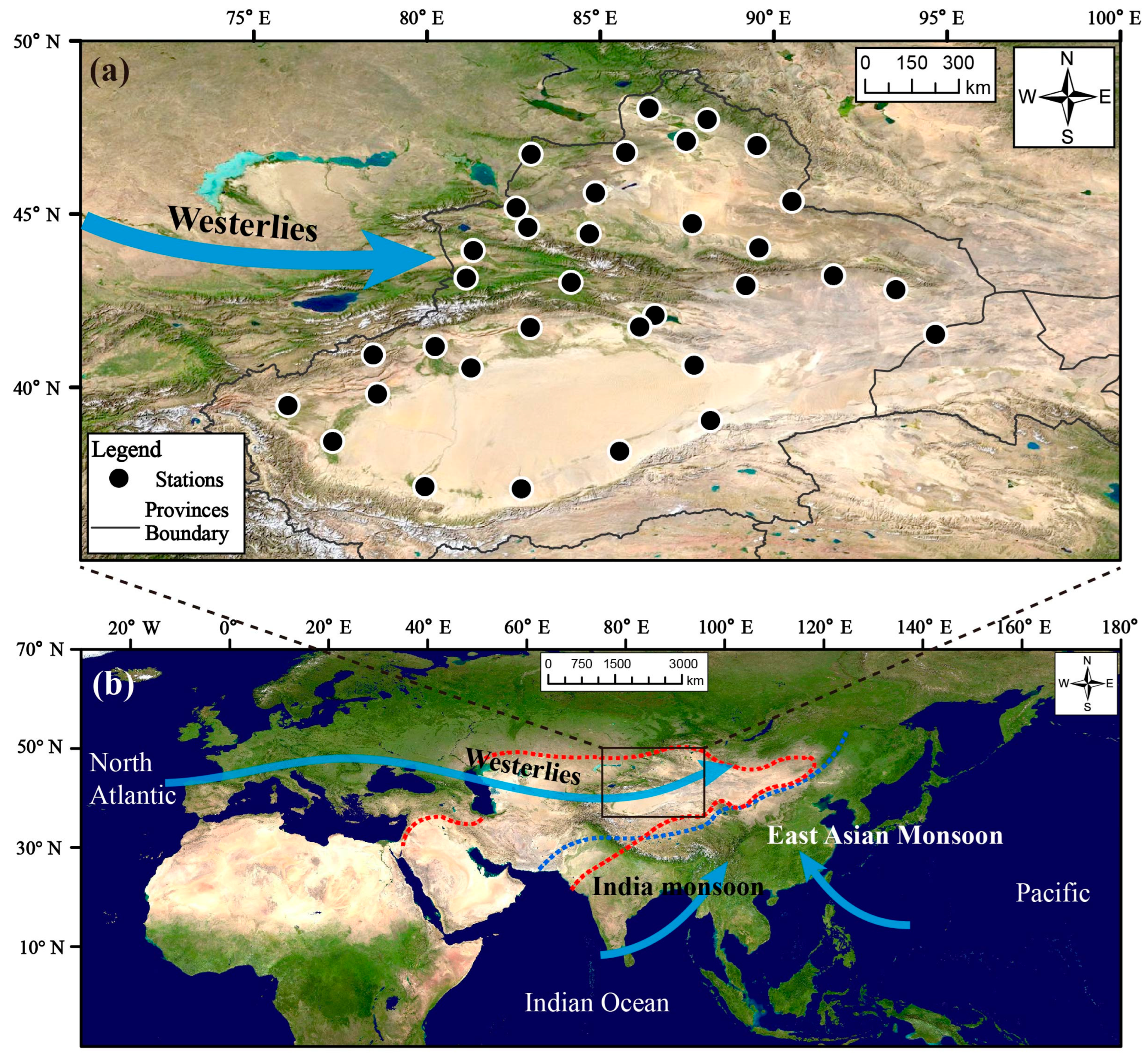
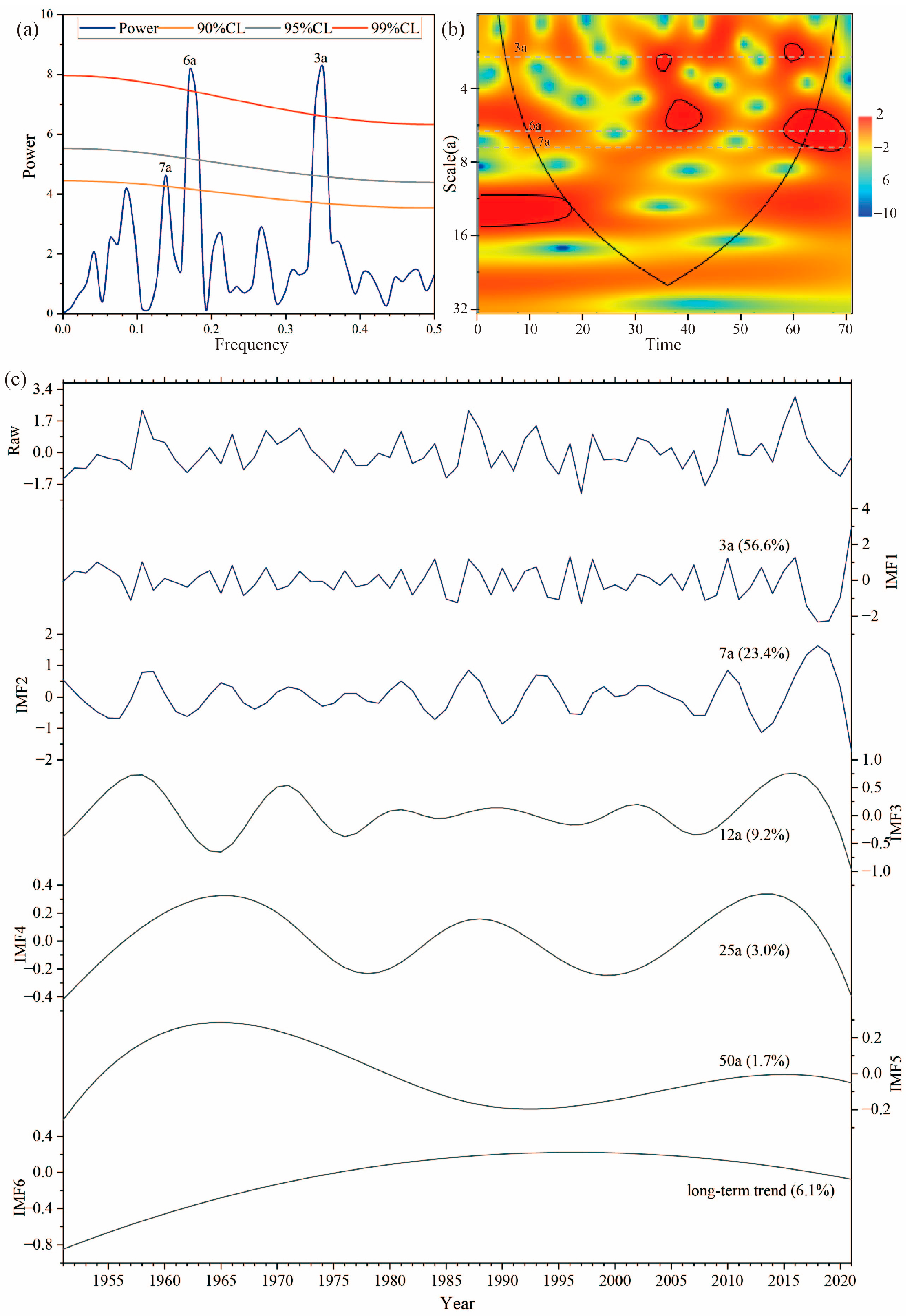
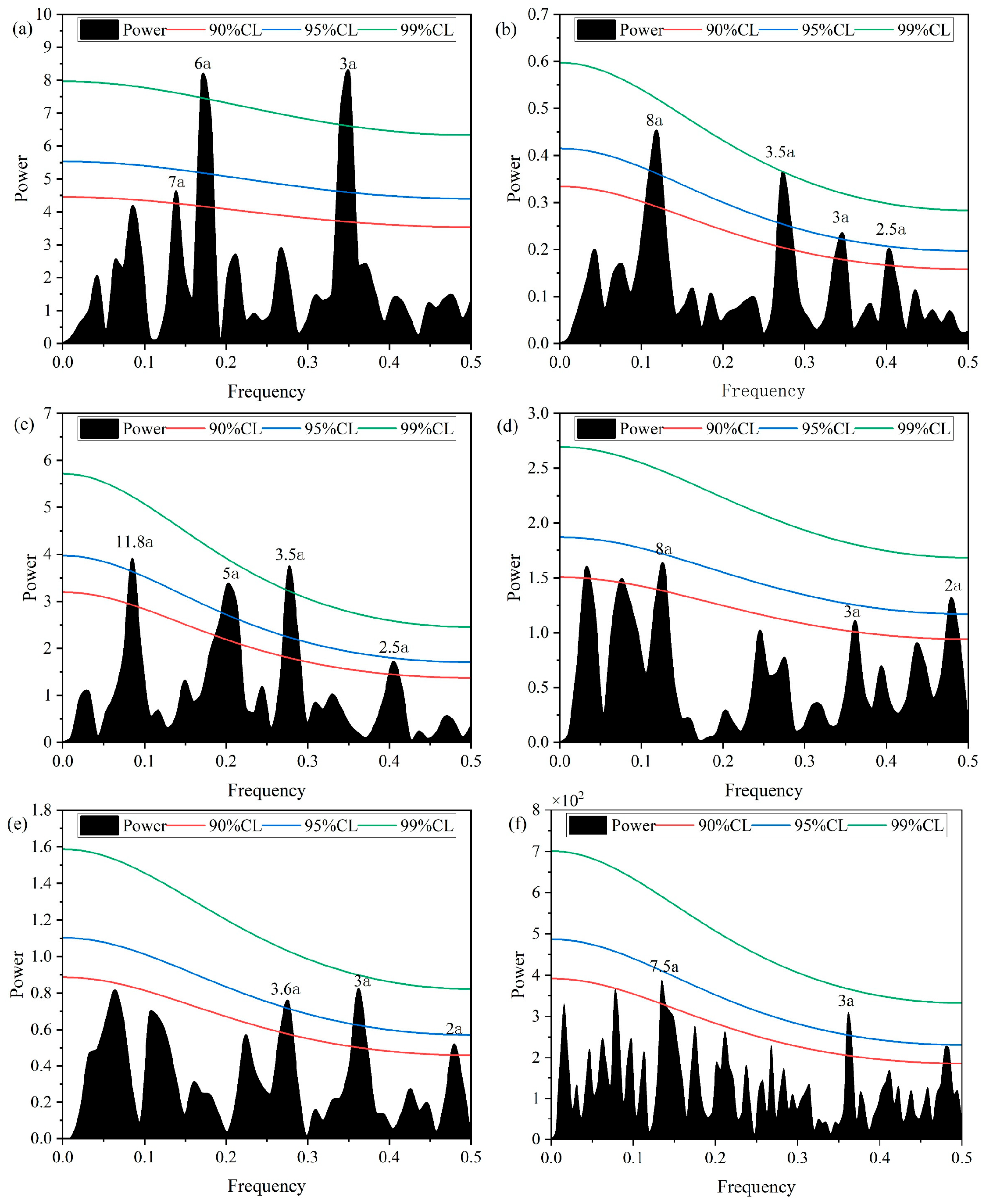
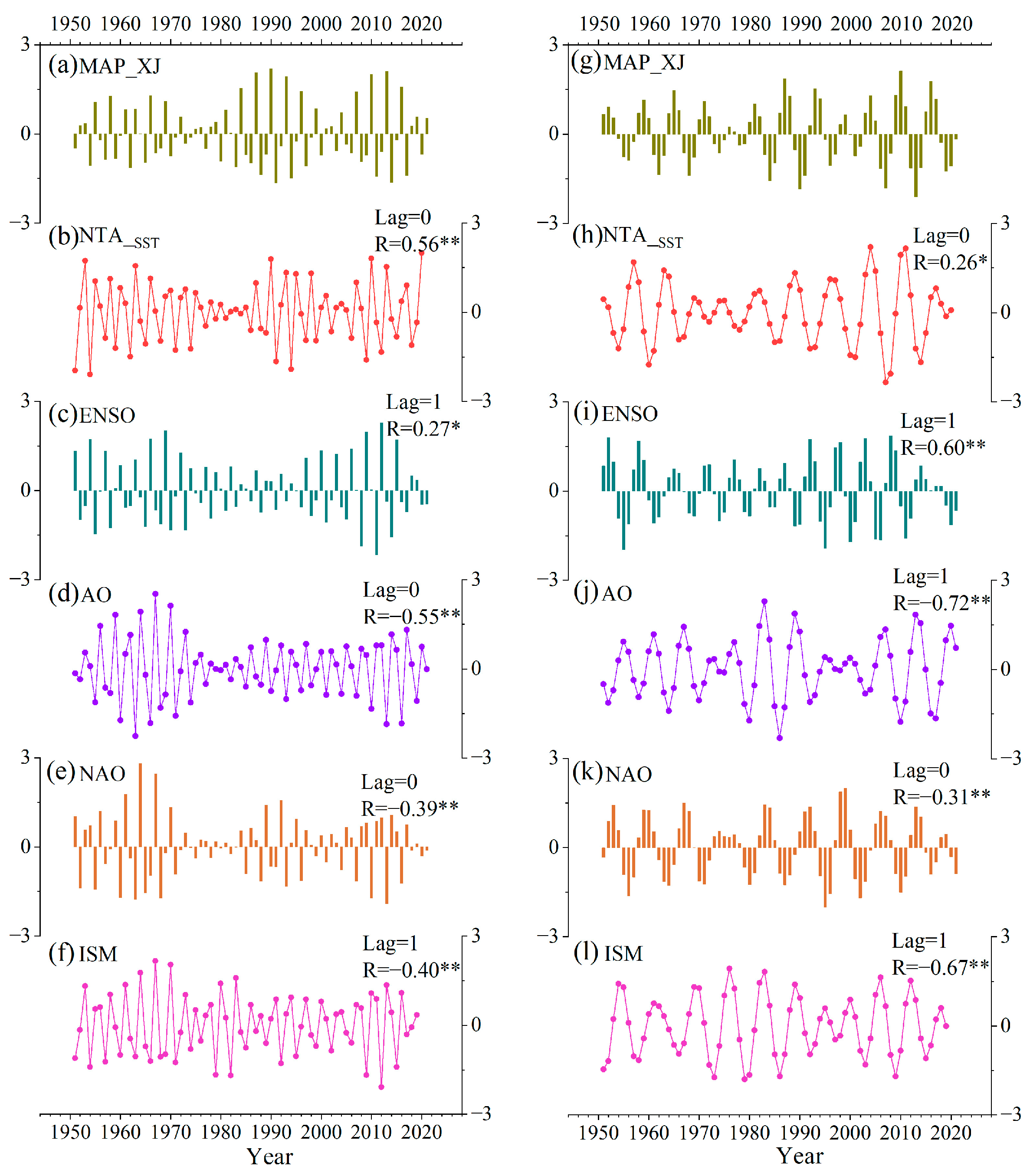
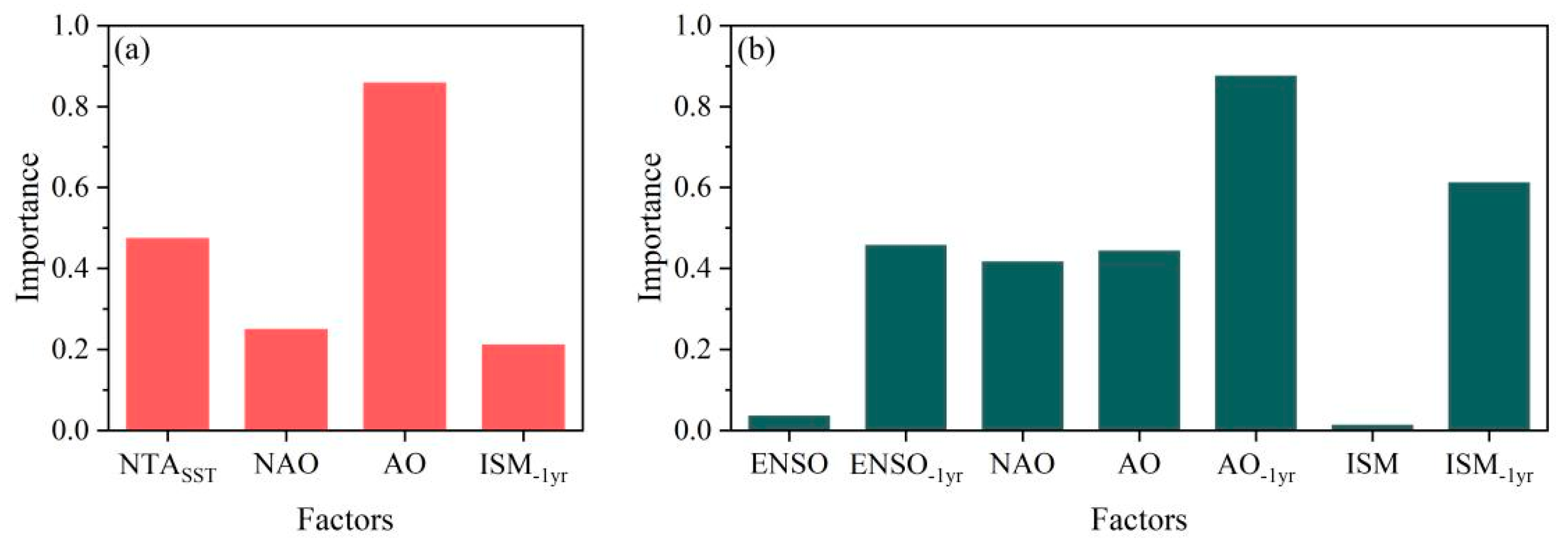
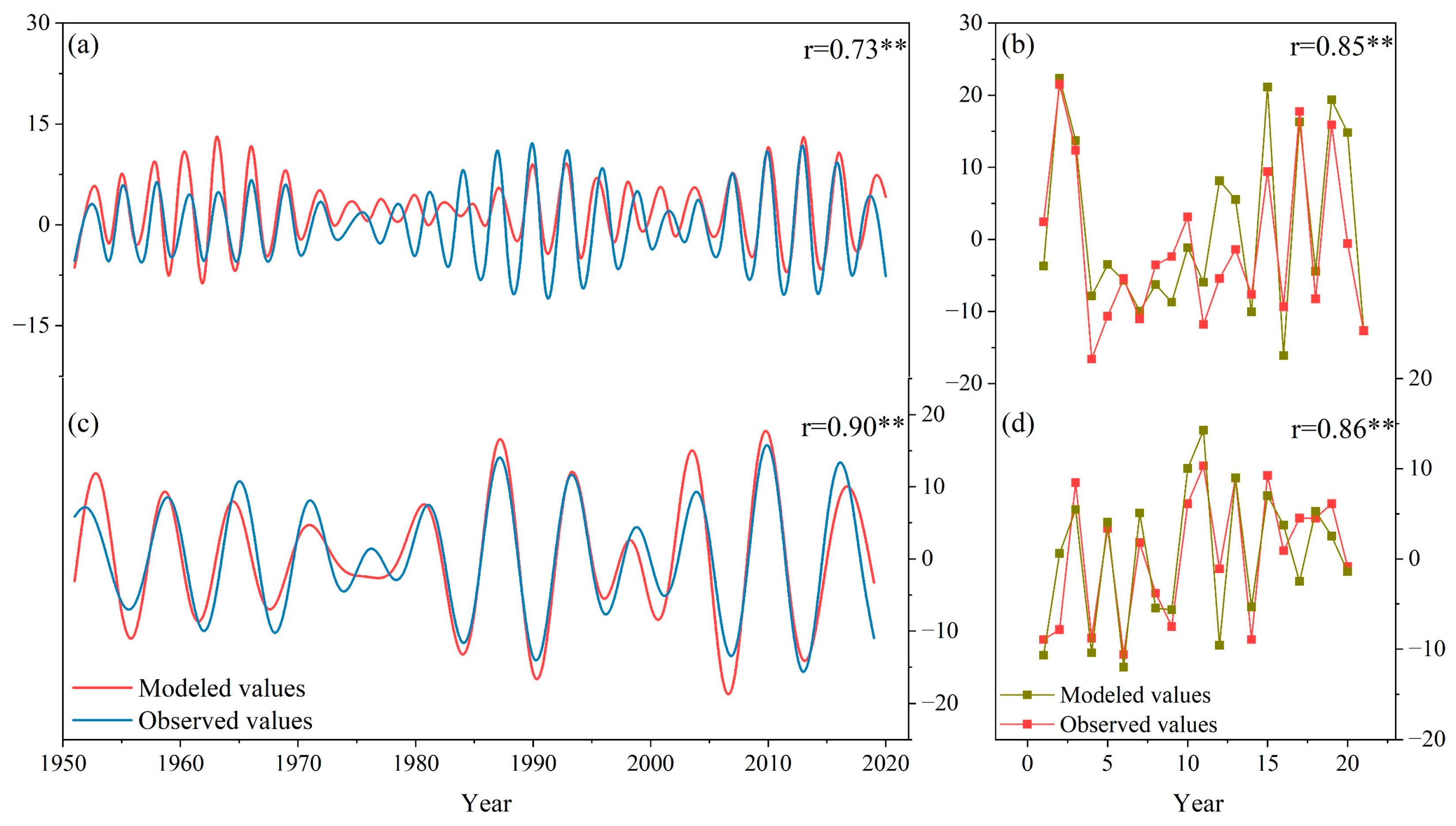
| Model | Unstandardized Coefficients | Standardized Coefficients | Collinearity Statistics | R2 | ||||
|---|---|---|---|---|---|---|---|---|
| B | Standard Error | Beta | t | Significance | Tolerance | VIF | ||
| (Constant) | −0.068 | 0.941 | −0.072 | 0.943 | 0.536 | |||
| NTASST | 35.121 | 8.947 | 0.386 | 3.925 | 0 | 0.738 | 1.355 | |
| NAO | 13.511 | 7.424 | 0.273 | 1.82 | 0.073 | 0.317 | 3.155 | |
| AO | −40.349 | 9.234 | −0.656 | −4.37 | 0 | 0.317 | 3.159 | |
| ISM−1yr | −0.309 | 0.191 | −0.156 | −1.615 | 0.111 | 0.769 | 1.301 | |
| Model | Unstandardized Coefficients | Standardized Coefficients | Collinearity Statistics | R2 | ||||
|---|---|---|---|---|---|---|---|---|
| B | Standard Error | Beta | t | Significance | Tolerance | VIF | ||
| (Constant) | −0.105 | 0.574 | −0.182 | 0.856 | 0.818 | |||
| ENSO | 7.384 | 2.454 | 0.225 | 3.008 | 0.004 | 0.533 | 1.877 | |
| ENSO−1yr | 14.829 | 2.384 | 0.457 | 6.222 | 0 | 0.552 | 1.811 | |
| NAO | −20.29 | 3.931 | −0.382 | −5.162 | 0 | 0.545 | 1.834 | |
| AO | −16.882 | 6.57 | −0.219 | −2.57 | 0.013 | 0.412 | 2.428 | |
| AO−1yr | −12.701 | 6.436 | −0.167 | −1.973 | 0.053 | 0.415 | 2.411 | |
| ISM | 0.752 | 0.247 | 0.299 | 3.046 | 0.003 | 0.31 | 3.227 | |
| ISM−1yr | −0.813 | 0.243 | −0.323 | −3.343 | 0.001 | 0.319 | 3.133 | |
Disclaimer/Publisher’s Note: The statements, opinions and data contained in all publications are solely those of the individual author(s) and contributor(s) and not of MDPI and/or the editor(s). MDPI and/or the editor(s) disclaim responsibility for any injury to people or property resulting from any ideas, methods, instructions or products referred to in the content. |
© 2025 by the authors. Licensee MDPI, Basel, Switzerland. This article is an open access article distributed under the terms and conditions of the Creative Commons Attribution (CC BY) license (https://creativecommons.org/licenses/by/4.0/).
Share and Cite
Ma, W.; Liu, X.; Shang, S.; Wang, Z.; Sun, Y.; Huang, J.; Ma, M.; Ma, M.; Tan, L. The Interannual Cyclicity of Precipitation in Xinjiang During the Past 70 Years and Its Contributing Factors. Atmosphere 2025, 16, 629. https://doi.org/10.3390/atmos16050629
Ma W, Liu X, Shang S, Wang Z, Sun Y, Huang J, Ma M, Ma M, Tan L. The Interannual Cyclicity of Precipitation in Xinjiang During the Past 70 Years and Its Contributing Factors. Atmosphere. 2025; 16(5):629. https://doi.org/10.3390/atmos16050629
Chicago/Turabian StyleMa, Wenjie, Xiaokang Liu, Shasha Shang, Zhen Wang, Yuyang Sun, Jian Huang, Mengfei Ma, Meihong Ma, and Liangcheng Tan. 2025. "The Interannual Cyclicity of Precipitation in Xinjiang During the Past 70 Years and Its Contributing Factors" Atmosphere 16, no. 5: 629. https://doi.org/10.3390/atmos16050629
APA StyleMa, W., Liu, X., Shang, S., Wang, Z., Sun, Y., Huang, J., Ma, M., Ma, M., & Tan, L. (2025). The Interannual Cyclicity of Precipitation in Xinjiang During the Past 70 Years and Its Contributing Factors. Atmosphere, 16(5), 629. https://doi.org/10.3390/atmos16050629






